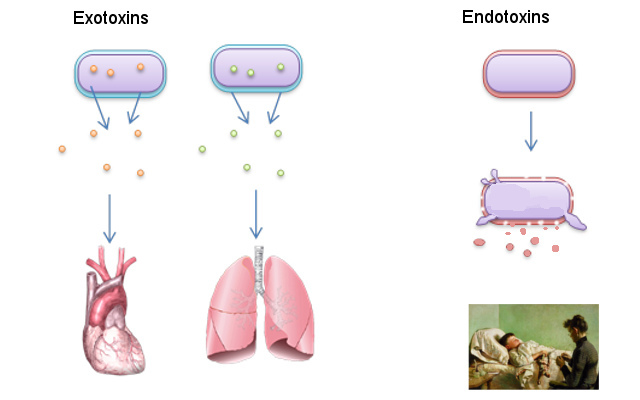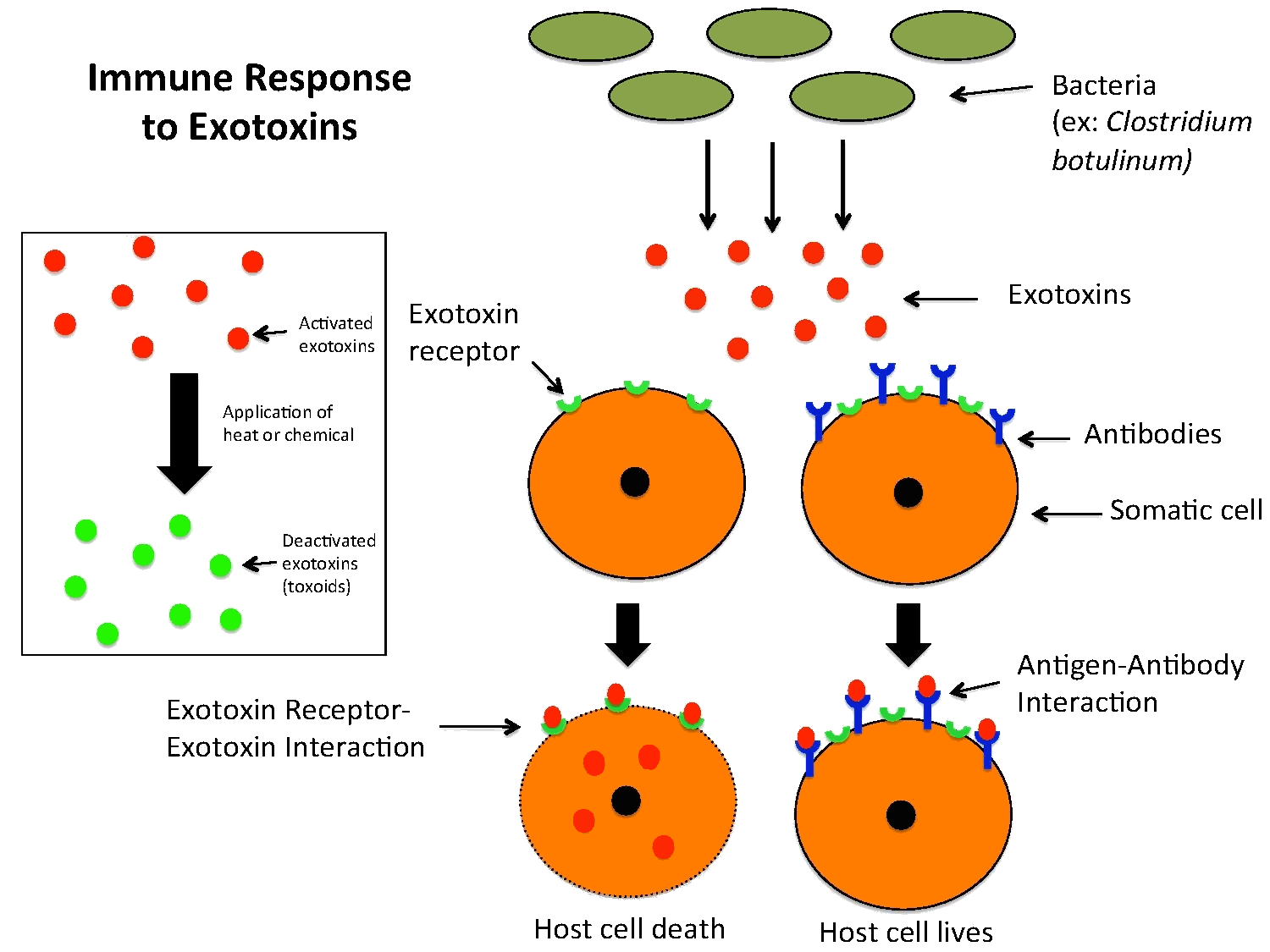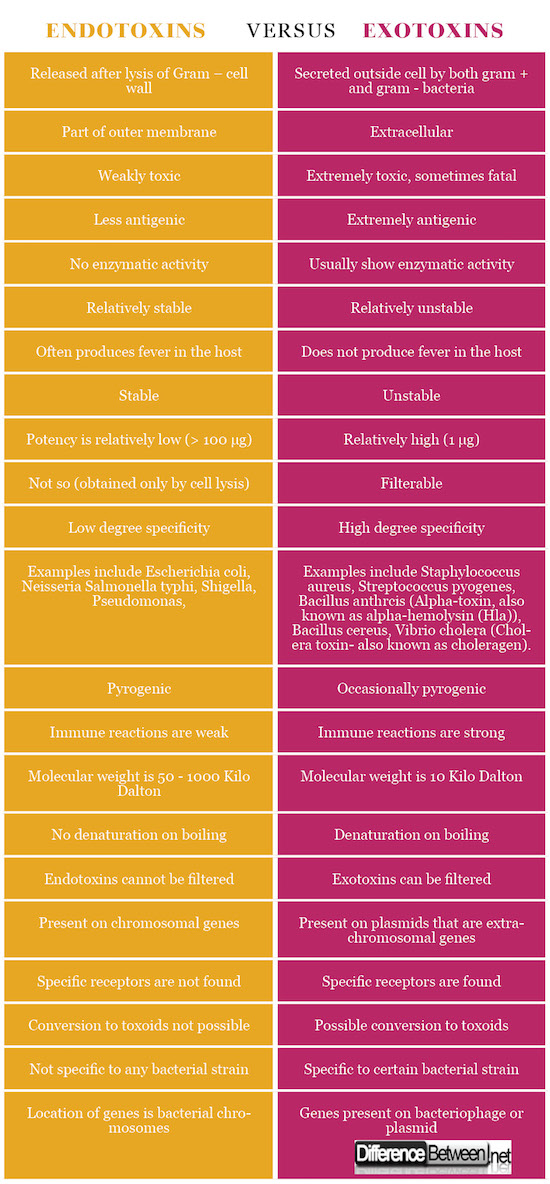Difference Between Endotoxins and Exotoxins
Toxigenesis involves production of toxins by pathogenic bacteria. It is one of the major methods of giving birth to diseases and medical disorders by bacteria. 2 categories of toxins that lead to various infections and diseases include; endotoxins and exotoxins and they are different based on their chemical nature. Endotoxins are bacterial toxins consisting of lipids (lipopolysaccharides) and exotoxins consist of proteins.
What is Endotoxins?
Endotoxins are lipopolysaccharides toxin released by Gram – bacteria. Endotoxins are cell bound and are produced only when the cell lyses. Endotoxins are present in the outer sheath of the cell wall in a gram – bacteria. Endotoxins are also called as lipopolysaccharides and are present in E coli, Shigella, Salmonella, Pseudomonas, Haemophilus influenza, Neisseria, and Vibrio cholerae. Endotoxins are usually secreted by developing bacteria due to the actions of specific antibiotics or at the action of phagocytic digestion.
Endotoxins show less potency and are not very active on their substrate. They exhibit heat stability. Outer wall of bacteria is impenetrable to bigger molecules and molecules that cannot dissolve in water and safeguard from the outer environment.
These toxins are a part of this safeguarding activity. It has sticking function on a host during the time of colonization. Also, endotoxins show poor antigenicity.
What is Exotoxins?
Exotoxins are toxins that are released extracellularly with the development of the organism. Exotoxins are contagious toxins that spread from the focus of infection to other parts of the body and cause damage. They are soluble proteins that acts as enzymes. An exotoxin has the ability to cause damage to the host by destructing cells or interfering with the normal cell metabolism. Exotoxins are highly potent and can cause extreme harm to the host. Exotoxins are excreted through their rapid growth or during their cell lysis. Both gram + and gram – bacteria produce exotoxins.
Exotoxins possess more toxicity as compared to endotoxins and they are distinguishing to certain bacteria strains. Exotoxins cause diseases only specific to that contamination. For e.g. Clostridium tetani forms tetanus toxin. There exist 3 major categories of exotoxins: Enterotoxins, neurotoxins and cytotoxins. These types indicate about the location of activity. Enterotoxemic activity can be seen on Gastro intestinal tract. Neurotoxins exhibit their functions on neurons and Cytotoxins destruct the host cell functioning. Some of the health disorders caused by exotoxins include Cholera, tetanus and Diphtheria. Antigenicity in exotoxins is quite high. Exotoxins trigger the immune system and secrete antitoxins to nullify the toxin.

Difference between Endotoxins and Exotoxins
Chemical nature of Endotoxins and Exotoxins
Endotoxins
Endotoxins are also known as Lipopolysaccharides of gram – bacteria. Endotoxins consist of 2 components possessing different physical and chemical characteristics: a hetero-polysaccharide and a covalently attached lipid, named lipid A.
Exotoxins
Exotoxins are toxins secreted by bacteria and chemical composition is of proteins.
Enzymes in Endotoxins and Exotoxins
Endotoxins
Catalase, Fibrolysin, IgA / IgG proteases
Exotoxins
Hyaluronidase, Collagenase, certain protease, Nuclease, Neuraminidase, Certain protease, Phospholipase A
Source of Endotoxins and Exotoxins
Endotoxins
Endotoxins are secreted by the cell membrane of the gram – bacteria only after lysis of the cells. Endotoxins are integral part of cell wall.
Exotoxins
Exotoxins are secreted by certain gram + and gram – bacteria
Location of Endotoxins and Exotoxins
Endotoxins
It is present inside the cell membrane and releases only after lysis of gram – cell wall.
Exotoxins
It is secreted outside the cell by both gram + and gram – bacteria.
Mode of action involved in Endotoxins and Exotoxins
Endotoxin
Includes TNF and Interlukin-1
Exotoxin
Various modes
Heat stability of Endotoxins and Exotoxins
Endotoxin
Endotoxins are heat tolerant and relatively stable at 250oC for one hour
Exotoxin
Exotoxins can get destroyed at 600-800C (heat liable). They are unstable except Staphylococcal enterotoxin.
Detection tests
Endotoxin
Detected by Limulus lysate assay test.
Exotoxin
Precipitation, ELISA-based methods, neutralization
Immunogenicity
Endotoxin
Endotoxins show weak immunogenicity. Endotoxins don’t produce antitoxins.
Exotoxin
Exotoxins are extremely immunogenic. They trigger the humoral responsiveness (antibodies target the toxins). By stimulation of the immune system, exotoxins secrete antitoxins to neutralize the toxin
Toxoid potential/Vaccines
Endotoxin
Toxoids cannot be made and there are no vaccines available.
Exotoxin
Toxoids can be made by treating with formaldehyde but treated toxins show immunogenicity. Toxoids can be used as vaccines.
Relation to micro organisms
Endotoxin
Located in LPS of outer sheath of cell wall and secreted with harming of cell or at the time of the cell multiplication.
Exotoxin
Metabolic product of developing cell.
Diseases
Endotoxins
Urinary tract infections, Typhoid fever, meningococcal meningitis, Coronary artery disease, Neonatal Necrotising Enterocolitis, Crohn’s Disease and Ulcerative Colitis, Cystic Fibrosis, Meningococcaemia, sepsis by gram negative rods, haemorrhagic shock
Exotoxins
Gas gangrene, Scarlet fever, Diphtheria, Botulism, tetanus, Antibiotic associated diarrhoea, Scalded skin syndrome.
Summary of Endotoxins vs. Exotoxins
The points of difference between Endotoxins and Exotoxins have been summarized below:
Comparison Table for Endotoxins and Exotoxins
- Difference Between Vaccination and Immunization - March 3, 2024
- Difference Between Selective Mutism and Autism - February 25, 2024
- Difference Between Depersonalization-Derealization and Dissociation - January 18, 2024
Search DifferenceBetween.net :
Leave a Response
References :
[0]Aryal, S. (2015). Differences Between Exotoxins and Endotoxins. Retrieved on February 3, 2018 from https://microbiologyinfo.com/differences-between-exotoxins-and-endotoxins/
[1]Bayston, K. F., & Cohen, J. (1990). Bacterial endotoxin and current concepts in the diagnosis and treatment of endotoxaemia. Journal of medical microbiology, 31(2), 73-83.
[2]Dinges, M. M., Orwin, P. M., & Schlievert, P. M. (2000). Exotoxins of Staphylococcus aureus. Clinical microbiology reviews, 13(1), 16-34.
[3]Raetz, C. R. (1990). Biochemistry of endotoxins. Annual review of biochemistry, 59(1), 129-170.
[4]Rietschel, E. T., & Brade, H. (1992). Bacterial endotoxins. Scientific american, 267(2), 54-61.
[5]Aryal, S. (2015). Differences Between Exotoxins and Endotoxins. Retrieved on February 3, 2018 from https://microbiologyinfo.com/differences-between-exotoxins-and-endotoxins/
[6]Image credit: https://commons.wikimedia.org/wiki/File:Immune_Response_to_Exotoxins.png#/media/File:Immune_Response_to_Exotoxins.png
[7]Image credit: https://www.flickr.com/photos/97216967@N04/9703845461



